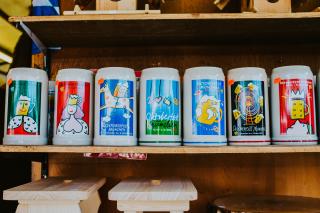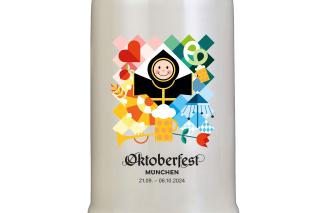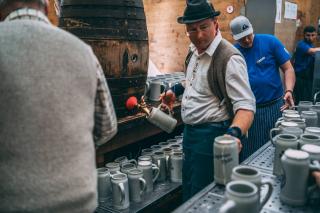Collectible Oktoberfest beer steins: Highly coveted souvenirs
The famous collector’s mugs are as much a part of the Oktoberfest as the brass band and the beer tent. Anyone who owns a complete series of all Oktoberfest mugs has a collector’s value of several thousand euros on their shelf. But how are the stone jugs actually made?

Stein mugs: First, the handle
Naturally, a good mug has to lie well in hand, and you have to be able to lift it reasonably. This is why the stone jugs that initially have no handles are given a clay handle, very carefully added by hand. A look at the finished result shows that there are true professionals at work here, because the handles of the many thousands of collector’s jugs look almost identical despite the handwork on each jug.
Handle and beer mug: Sponging
The next work step is the sponging. The transitions between the handle and the jug are smoothed with a damp sponge so that the surface becomes completely even. If you didn’t know better, you would never realize that the handle is only “taped” to the mug after the fact.
The first firing process
That’s when things get hot. The mugs are fired at about 1,000 degrees Celsius (1,800 degrees Fahrenheit) in a large brick kiln. Under this heat, the stone jugs harden. It’s clear that they need to cool down before the next operation. Who likes to handle hot stone?
The Oktoberfest motif comes to the jug: Decorating
Nobody’s interested in a “naked” stein mug. This is why the Oktoberfest collector’s mugs captivate guests year after year with an elaborate decoration. For this purpose, the official Oktoberfest motif, which changes every year and can be seen on the posters, is placed on the mug by hand and carefully smoothed to avoid wrinkles. Now the beer mug looks almost like a real Oktoberfest stein, but a few little things are still missing.

Borders: Hand-brushed
With the coveted collector’s mugs, attention is of course paid to every detail, including the border. This is colored and is painted with a fine brush around the mug. A rotating disc on which the Oktoberfest mug stands during the bordering process ensures perfect results, even with unsteady hands.
The second firing process
In order to keep together what belongs together, the Oktoberfest motif is permanently applied to the surface of the beer mug by another firing process. For the collector’s mug without a lid, the creation process ends here. The Oktoberfest stein with tin lid has yet another step ahead of it.
The matching lid for the mug: Covering
The crowning glory is the lid on the Oktoberfest stein. The solid pewter lids are handmade and, like the whole jug, are worked with great attention to detail. In the anniversary year of 2010, for example, the lid was decorated with a delicate embossing of the royal wedding couple Crown Prince Ludwig and Therese von Hildburghausen. The same motif was found on an anniversary medal from 1935. Whether your Oktoberfest stein mug actually goes on the shelf or in the showcase, only serving to look at or whether you indulge in a good Oktoberfest beer every now and then, is of course up to you.
Ad



